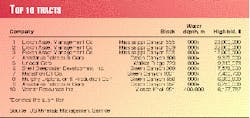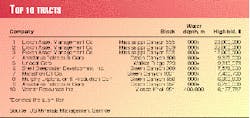Although 63 companies submitted bids at central Gulf of Mexico Lease Sale No. 175, observers said it was a decent but unspectacular turnout with many near-minimum bids.
In some quarters, it was expected that this last central gulf sale for which the Deep Water Royalty Relief Act of 1995 was in effect would be stronger than it was. The act is due to expire this year, after the next western gulf sale in August.
One reason for the lower-than-expected turnout could be that all the most prospective blocks have been taken, says Bob Stewart of the National Ocean Industries Association. "It's pretty picked over," he said.
Nevertheless, US Minerals Management Service Regional Director Chris Oynes considers it a successful sale.
Of the 4,203 blocks offered, only 344 received bids, while 469 bids were made overall.
In the last central gulf sale-Sale 172 in March 1999-67 companies made 272 bids on 207 tracts (OGJ, Mar. 22, 1999, p. 40).
The MMS will review each high bid before deciding whether to accept it.
Statistics
In Lease Sale 175, the 63 companies bidding on 1,764,389 acres exposed $454,929,870. The total of apparent high bids was $300,567,675. This total was made up of several markedly higher bids and many that were only the minimum or slightly higher, according to commentary at the sale.
The depth category with the most blocks receiving bids was, as usual, 0-200 m, with 202 blocks bid. This was followed by 800+ m with 116, 400-800 m with 18, and finally 200-400 m with only 8 blocks bid.
Blocks in water depths of 200 m or less attracted $112,252,430 in total bids and $94,902,268 in high bids. The deepest water category continued its strong recent showing, attracting $323,677,835 in total bids and $188,585,802 in high bids.
The deepest-water block to receive a bid was Walker Ridge 812, which lies in 3,379 m. It attracted one bid for $228,080 from a group of Amerada Hess Corp., Burlington Resources Offshore Inc., and Vastar Resources Inc.
Top 10 participants
Anadarko Petroleum Corp. submitted, alone or with partners, the most apparent high bids of the sale, 33. The total of its high bids was $24,891,450. The blocks cover 166,482 acres in water depths from 229 ft to 4,400 ft.
"We continue to see great opportunities in the Gulf of Mexico,'' said Robert J. Allison Jr., Anadarko chairman and CEO. "The results of this lease sale reflect our commitment to building an exploration portfolio that is appropriately balanced between traditional shallow-water areas and nontraditional plays such as the subsalt and deep water.''
A close second was Vastar, which submitted 27 high bids for a total of $27,862,464.
The rest of the top 10 high bidders, based on total high bids of the sale, were: Chevron USA Inc., 26 high bids; Spinnaker Exploration Co. LLC, 21; EEX Corp., 21; Kerr-McGee Oil & Gas Corp., 19; Samedan Oil Corp., 16; CNG Producing Co., 14; Murphy Exploration & Production Co., 14; and Marathon Oil Co., 13.
Exxon spent the most money at the sale. It made 14 bids, risking $65,300,000.
Exxon was high bidder on 11 bids, worth a combined $61,000,000.
Exxon submitted the top three bids of the sale: $23 million for Mississippi Canyon 555, $22 million for Mississippi Canyon 509, and $12 million for Mississippi Canyon 508. Those three blocks were also the most hotly contested; eight companies and combines bid for each of those blocks.
Stewart said these blocks are near large discoveries in the Mississippi Canyon area. He added that about half of the tracts bid for at the sale were previously leased and have been surrendered-including these three-and that these three blocks are somewhat near BP Amoco PLC's Crazy Horse field, which is believed to contain 1 billion bbl of oil.
The 10 tracts receiving the highest bids are listed in the table.
Feedback
MMS spokesman Barney Congdon said that, overall, the MMS is pleased with the sale. Congdon indicated that part of the bid total may have been driven by current high oil prices-higher oil prices make for larger acquisition budgets.
Still, Congdon said, companies operating in the Gulf of Mexico seem to be turning more to exploration and production than lease acquisition; otherwise, the sale numbers would have been bigger.
He mentioned that many companies already have a large lease inventory in the Gulf of Mexico, some of which is subject to the Deep Water Royalty Relief Act.
The act allows the US Secretary of the Interior to suspend royalty payments on the first 87.5 million boe produced from a field in water deeper than 200 m. The purpose is to encourage development and production from deepwater Gulf of Mexico leases. The high inventories of these leases made it less urgent to bid before the act expires in November, Congdon says.
Stewart said that, all in all, it was a good sale with lots of competition. As usual, independents made a strong showing with plenty of bids. He thinks competition would have been higher, except that most of the highly prospective acreage in the Gulf of Mexico has been leased.

